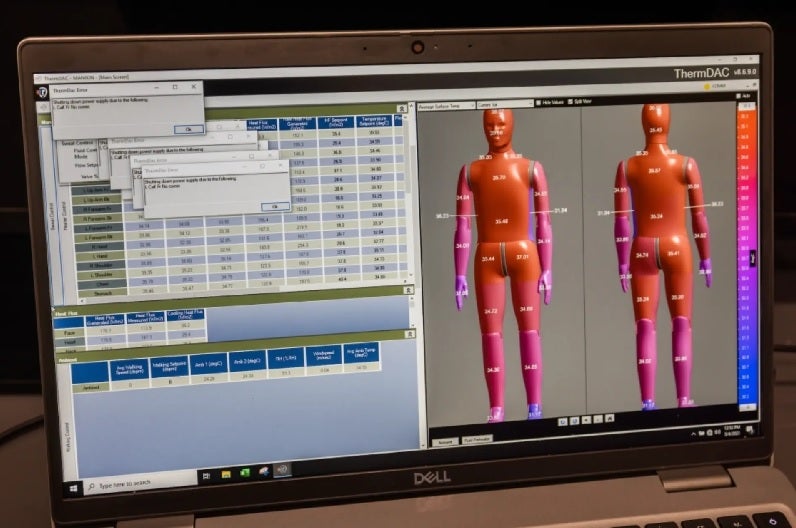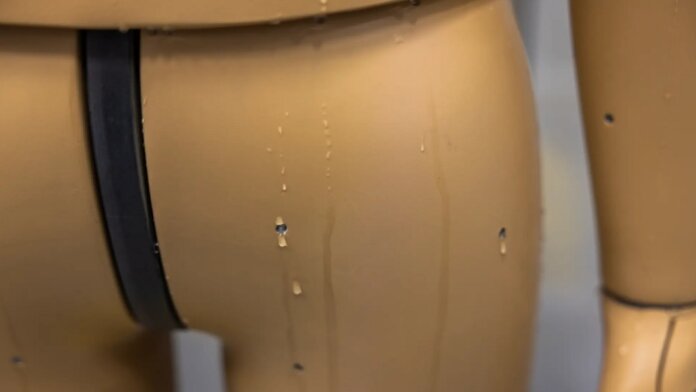It’s been a hot summer, with heat waves engulfing multiple parts of the world and setting record temperatures in some. We can hope that in time some of the measures being taken to fight climate change—from switching to renewable energy to capturing atmospheric carbon to using more sustainable building materials—will make a difference, and the planet won’t be so hot. But until then we’re going to have to adapt, on multiple levels: our activities, our habits, our homes, and even our bodies.
A robot named ANDI may be able to help with the latter. ANDI is like the mannequins you see in department stores, except it can walk, breathe, and sweat. It was designed by a company called Thermetrics and is mostly used by clothing companies to test athletic wear. But researchers at Arizona State University are now using it to learn more about how the human body responds to extreme heat, in hopes of finding new ways to help us live more comfortably and safely in hot climates.
“You can’t put humans in dangerous extreme heat situations and test what would happen,” said Jenni Vanos, a professor at ASU’s School of Sustainability who studies extreme heat and human health. “But there are situations we know of…where people are dying of heat and we still don’t fully understand what happened. ANDI can help us figure that out.”
The robot’s body is divided into 35 different surface areas. Each area has its own temperature sensors and pores that emit sweat. The “sweat” comes from internal cooling channels—that is, tubes that let water circulate through the body to help keep its temperature down. The robot “breathes” using an external tank that measures hot air exchange between it and the surrounding environment.
Researchers can calibrate ANDI’s settings to mimic how different peoples’ bodies would respond to extreme heat. “We can move different BMI models, different age characteristics, and different medical conditions (into ANDI),” said Ankit Joshi, an ASU research scientist leading the modeling work and the lead operator of ANDI. “A diabetes patient has different thermal regulation from a healthy person. So we can account for all this modification with our customized models.” They can also have the bot simulate walking and other forms of exertion to monitor how its internal temperature is affected.
And the human-body-mimicking robot has a sidekick. While ANDI is used to measure heat’s effect on the body, its buddy MaRTy takes in data about the surrounding environment, like how much heat is coming from the sun versus infrared radiation from the ground or convection from the surrounding air.

ANDI was initially tested in an indoor heat chamber that could get up to 140 degrees Fahrenheit. But who needs a heat chamber when you live in Arizona in the summer? The bot is now being tested outdoors (accompanied by MaRTy), both on ASU’s Tempe campus and around different parts of Phoenix. Researchers are particularly interested in taking the duo to what they call heat-vulnerable environments, which could include paved streets that don’t have any tree cover or old homes that don’t have air conditioning.
We already know that the best things to do in extreme heat are to stay out of the sun (ideally indoors in an air-conditioned environment), minimize physical activity, and stay hydrated. So what might the researchers be hoping to learn that would deviate from these guidelines?
According to Konrad Rykaczewski, principal investigator on the project,“There’s a lot of great work out there for extreme heat, but there’s also a lot missing. We’re trying to develop a very good understanding (of how heat impacts the human body) so we can quantitatively design things to address it.” Those things could include clothing made out of special materials to keep people cool, or backpacks or other wearables with built-in cooling mechanisms.
The team has its work cut out for it. This month, the Phoenix area saw more than three weeks straight of temperatures at or over 110 degrees, and the World Meteorological Association predicts global temperatures will reach new records in the next five years.
Given these dire forecasts, moving to a northern US state (or Canada) is sounding like a pretty good idea. Let’s hope ANDI sheds new light on how humans can not only survive in hot climates, but thrive in them.
Image Credit: Christopher Goulet/Arizona State University



